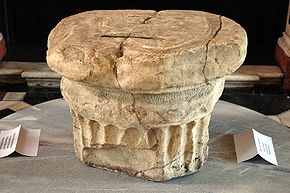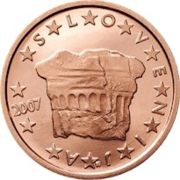
Prince's Stone
Encyclopedia


Ionic order
The Ionic order forms one of the three orders or organizational systems of classical architecture, the other two canonic orders being the Doric and the Corinthian...
column that played an important role in the ceremony surrounding the installation of the princes of Carantania in the Early Middle Ages
Early Middle Ages
The Early Middle Ages was the period of European history lasting from the 5th century to approximately 1000. The Early Middle Ages followed the decline of the Western Roman Empire and preceded the High Middle Ages...
. After the incorporation into the Frankish Empire the procedure held in Slovene language was continued as the first part of the coronation of the Dukes of Carinthia
Duchy of Carinthia
The Duchy of Carinthia was a duchy located in southern Austria and parts of northern Slovenia. It was separated from the Duchy of Bavaria in 976, then the first newly created Imperial State beside the original German stem duchies....
, followed by a mass
Mass (liturgy)
"Mass" is one of the names by which the sacrament of the Eucharist is called in the Roman Catholic Church: others are "Eucharist", the "Lord's Supper", the "Breaking of Bread", the "Eucharistic assembly ", the "memorial of the Lord's Passion and Resurrection", the "Holy Sacrifice", the "Holy and...
at Maria Saal
Maria Saal
Maria Saal is a market town in the district of Klagenfurt-Land in the Austrian state of Carinthia. It is located in the east of the historic Zollfeld plain , the wide valley of the Glan river. The municipality includes the cadastral communes of Kading, Karnburg, Möderndorf, Possau and St...
cathedral and the installation at the Duke's chair
Duke's Chair
The Duke's Chair, also known as the Duke's Seat , is a medieval stone seat dating from the ninth century and located at the Zollfeld plain near Maria Saal north of Klagenfurt in the Austrian state of Carinthia.-History:...
, where he swore an oath in German
German language
German is a West Germanic language, related to and classified alongside English and Dutch. With an estimated 90 – 98 million native speakers, German is one of the world's major languages and is the most widely-spoken first language in the European Union....
and received the homage of the estates.
History
The column probably originates from the nearby RomanRoman Empire
The Roman Empire was the post-Republican period of the ancient Roman civilization, characterised by an autocratic form of government and large territorial holdings in Europe and around the Mediterranean....
city of Virunum
Virunum
Claudium Virunum was a Roman city in the province of Noricum, on today's Zollfeld in the Austrian State of Carinthia. Virunum may also have been the name of the older Celtic-Roman settlement on the hilltop of Magdalensberg nearby....
, established as capital of the Noricum
Noricum
Noricum, in ancient geography, was a Celtic kingdom stretching over the area of today's Austria and a part of Slovenia. It became a province of the Roman Empire...
province under the reign of Emperor Claudius
Claudius
Claudius , was Roman Emperor from 41 to 54. A member of the Julio-Claudian dynasty, he was the son of Drusus and Antonia Minor. He was born at Lugdunum in Gaul and was the first Roman Emperor to be born outside Italy...
(41-54). During the Middle Ages the coat of arms of the Duchy of Carinthia
Duchy of Carinthia
The Duchy of Carinthia was a duchy located in southern Austria and parts of northern Slovenia. It was separated from the Duchy of Bavaria in 976, then the first newly created Imperial State beside the original German stem duchies....
were engraved at its top surface. Till 1862, when it was transferred to the Landhaus provincial assembly at Klagenfurt
Klagenfurt
-Name:Carinthia's eminent linguists Primus Lessiak and Eberhard Kranzmayer assumed that the city's name, which literally translates as "ford of lament" or "ford of complaints", had something to do with the superstitious thought that fateful fairies or demons tend to live around treacherous waters...
, it stood northwest of the Kaiserpfalz
Kaiserpfalz
The term Kaiserpfalz or Königspfalz refers to a number of castles across the Holy Roman Empire which served as temporary, secondary seats of power for the Holy Roman Emperor in the Early and High Middle Ages...
of Karnburg (Slovene: ) in the Zollfeld
Zollfeld
Zollfeld is a slightly ascending plain in Carinthia, Austria. It is one of the oldest cultural landscapes in the East Alpine region.-Geography:...
plain, built by Emperor Arnulf of Carinthia
Arnulf of Carinthia
Arnulf of Carinthia was the Carolingian King of East Francia from 887, the disputed King of Italy from 894 and the disputed Holy Roman Emperor from February 22, 896 until his death.-Birth and Illegitimacy:...
.
The first mention of a sedes Karinthani ducatus in the course of the installation of Herman II of Sponheim
Herman II, Duke of Carinthia
Herman II of Sponheim, Duke of Carinthia ruled the Duchy of Carinthia from 1161 to his death. -Family:A scion of the House of Sponheim, he was a son of Margrave Engelbert III of Istria and Matilda of Sulzbach...
in 1161 possibly referred to the Prince's Stone. The ceremony was explicitly described about 1341 by the chronicler John of Viktring
John of Viktring
John of Viktring was a late medieval chronicler and political advisor to the rulers of Carinthia. He is also known as Johannes Victorensis, Johannes de Victoria, John of Victring, Johann von Viktring, or Joannes Victoriensis. In Slovene he is called Janez Vetrinjski.Nothing is known of John's...
in his liber certarum historiarum on the occasion of the coronation of Meinhard II of Gorizia-Tyrol
Meinhard, Duke of Carinthia
Meinhard II from the House of Meinhardin was ruling Count of Gorizia from 1258 until 1271 and Count of Tyrol from 1258 until his death...
in 1286: when the duke-to-be approached he found a free peasant sitting on the stone. Not before Meinhard had assured him he was worthy to accede to the throne and would be a just ruler would the peasant vacate his position.
The partition of Carinthia
Carinthian Plebiscite
The Carinthian Plebiscite on 10 October 1920 determined the final southern border between the Republic of Austria and the newly formed Kingdom of Serbs, Croats and Slovenes after World War I.- History :...
after World War I made the Prince's stone a part of the common and therefore disputed Carantanian heritage. When in 2005 the Slovenia
Slovenia
Slovenia , officially the Republic of Slovenia , is a country in Central and Southeastern Europe touching the Alps and bordering the Mediterranean. Slovenia borders Italy to the west, Croatia to the south and east, Hungary to the northeast, and Austria to the north, and also has a small portion of...
n government of prime minister Janez Janša
Janez Janša
Janez Janša is a Slovenian politician who was Prime Minister of Slovenia from November 2004 to November 2008. He has also been President of the Slovenian Democratic Party since 1993...
decided to depict the Prince's Stone on the national side of the Slovenian 2 cent coin
Slovenian euro coins
Slovenian euro coins were first issued for circulation on 1 January 2007 and a unique feature is designed for each coin. The design of approximately 230 million Slovenian euro coins was unveiled on 7 October 2005. The designers were Miljenko Licul, Maja Licul and Janez Boljka...
, it caused some consternation in Austria. In 2006 the Carinthian
Carinthia (state)
Carinthia is the southernmost Austrian state or Land. Situated within the Eastern Alps it is chiefly noted for its mountains and lakes.The main language is German. Its regional dialects belong to the Southern Austro-Bavarian group...
governor Jörg Haider
Jörg Haider
Jörg Haider was an Austrian politician. He was Governor of Carinthia on two occasions, the long-time leader of the Austrian Freedom Party and later Chairman of the Alliance for the Future of Austria , a breakaway party from the FPÖ.Haider was controversial within Austria and abroad for comments...
had the stone, that since 1905 had been displayed at the Carinthian State Museum, transferred again to the Heraldic Hall at the Klagenfurt Landhaus.

